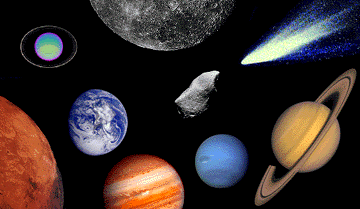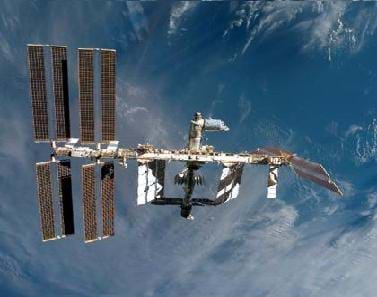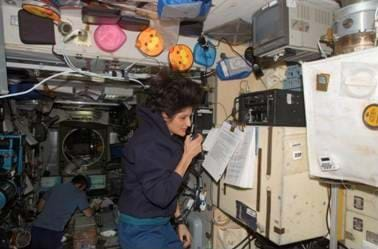Quick Look
Grade Level: 8 (7-9)
Time Required: 15 minutes
Lesson Dependency: None
Subject Areas: Earth and Space, Science and Technology

Summary
Students are introduced to the historical motivation for space exploration. They learn about the International Space Station as an example of space travel innovation and are introduced to new and futuristic ideas that space engineers are currently working on to propel space research far into the future!Engineering Connection
Space travel is made possible by engineers. From mechanical engineers who design the components for spacecraft to biomedical engineers who design ways to care for astronauts' health while traveling in space, people from almost every discipline of engineering work together to further space exploration.
Learning Objectives
After this lesson, students should be able to:
- Identify potential reasons why people want to travel to space.
- Describe how different types of engineers each contribute to space travel.
- Give examples of what the future may hold for space travel.
Educational Standards
Each TeachEngineering lesson or activity is correlated to one or more K-12 science,
technology, engineering or math (STEM) educational standards.
All 100,000+ K-12 STEM standards covered in TeachEngineering are collected, maintained and packaged by the Achievement Standards Network (ASN),
a project of D2L (www.achievementstandards.org).
In the ASN, standards are hierarchically structured: first by source; e.g., by state; within source by type; e.g., science or mathematics;
within type by subtype, then by grade, etc.
Each TeachEngineering lesson or activity is correlated to one or more K-12 science, technology, engineering or math (STEM) educational standards.
All 100,000+ K-12 STEM standards covered in TeachEngineering are collected, maintained and packaged by the Achievement Standards Network (ASN), a project of D2L (www.achievementstandards.org).
In the ASN, standards are hierarchically structured: first by source; e.g., by state; within source by type; e.g., science or mathematics; within type by subtype, then by grade, etc.
International Technology and Engineering Educators Association - Technology
-
Transportation vehicles are made up of subsystems, such as structural propulsion, suspension, guidance, control, and support, that must function together for a system to work effectively.
(Grades
6 -
8)
More Details
Do you agree with this alignment?
-
Analyze how an invention or innovation was influenced by its historical context.
(Grades
6 -
8)
More Details
Do you agree with this alignment?
State Standards
Colorado - Science
-
Describe methods and equipment used to explore the solar system and beyond
(Grade
8)
More Details
Do you agree with this alignment?
Introduction/Motivation
(Note: Prior to beginning this lesson introduction, guide students through a brief pre-lesson assessment activity on journaling, as described in the Assessment section.)
Let us begin by having you share your journal entries on your journey through space. What do you imagine it would be like to travel into space? What questions do you have about the solar system and outer space? (Call on students to share their ideas.) Great ideas and questions! Do you have any idea how long you think a person could live in outer space? What kind of equipment would she or he need to survive? Today we will be studying a space project that many engineers have been working on that makes it possible to travel to and live in space.
But first let's think about why people would want to travel to space in the first place. You wrote in your journal about things you might explore in space. Tell me about your investigation plans. (Call on students to share their ideas. Write ideas on the board.) Good! What are other reasons that space scientists might want to explore outer space? (Ask some of the following questions if students did not already mention these ideas. Write ideas or groups of topics on the board.)
- Evidence of life: "Do you think life exists on other planets? How could we find out?"
- Gravity-free experiments: "Why might scientists be interested in performing experiments in a gravity-free environment?"
- Earth's origins: "In what ways could the exploration of the moon and our solar system tell us about our own planet's origin?"
- Colonizing other planets: "Do you think we could someday colonize the moon or another planet? Why would we want to? What would we need to figure out to make that possible?"
Excellent! Now we have an idea of why people might like to travel to space. But, who actually makes space travel possible? Engineers are the creative problem solvers who help shape the future of space travel. People from nearly every discipline —or branch of study—of engineering work together to further space exploration. Aerospace engineers design the craft, mechanical engineers design the components for the craft, electrical and computer engineers design the computer systems, and chemical engineers design the rocket fuel, among the many others who have a hand in a spacecraft's launch into outer space. What role do you think biomedical engineers have in space travel? (Answer: they design the medical devices to monitor and keep healthy the traveling astronauts.)
Let's look at an example of a space project that sounds like something out of a science fiction movie, but is actually a real project that engineers from around the world have worked on together to build for our use today! The International Space Station, or ISS for short, is designed to help scientists study questions such as the ones you came up with during your journaling activity. Astronauts—who have trained for months, if not years—live in the ISS for up to about six months at a time! Can you imagine?! While aboard the ISS, astronauts perform experiments that can only be done in space. Also, another purpose during their stay is to discover what is necessary to live in space for an extended period of time, so that longer journeys into the solar system can be planned (and carried out), such as to Mars or beyond.
The ISS is slightly bigger than a football field, and the living area for the 3-6 on-board astronauts is about the size of an average three-bedroom house (see Figure 2). How do you think life might be different for the astronauts who live there, based on the fact that they are in space and in such confined quarters? (This might be a good time to visit NASA's Interactive Space Station Reference Guide at https://www.nasa.gov/mission_pages/station/multimedia/index.html, which provides detailed visual answers to this question, as well as video clips showing how astronauts eat, sleep and exercise while on board the ISS.)

The ISS is not only an adventure in space living, it is also an adventure in science and engineering. The ISS is one of the most complex engineering projects ever designed. Engineers had to solve many difficult problems, such as how to get such a massive object to orbit the Earth, how to design ways to get astronauts on and off the space station, and how to provide electrical power to the station. Following the lesson students can expand their knowledge by combining design and creative thinking with the associated activity Solar Sails: The Future of Space Travel in which they will design, construct and test model solar sails made of foil that move cardboard tube satellites on a string through “space,” as a way to learn about new innovations, the universal laws of motion, and the transfer of energy from wave to mechanical energy.
Lesson Background and Concepts for Teachers
What is the International Space Station?
The International Space Station, or ISS for short, began in-space assembly in 1998 and is still under construction (as of fall 2008, at the time of this writing). The largest international space research station in history, sixteen countries including the U.S., Russia, Canada, Japan and Brazil joined together to conduct science experiments and research in space to determine whether human beings have a future in space. Research topics include life in low gravity, physics, Earth observation.
The ISS is about 25% larger than a football field and weighs more than one million pounds. Orbiting 240 miles above Earth and traveling at a speed of about 28,000 kilometers an hour, the ISS circles the Earth about 16 times a day. The station is able to observe 85% of the planet and 95% of the Earth's population from its variable and frequent orbit. Although small, the living quarters give the crew a great view of space and the Earth.
Crew and supplies can access the station during NASA's scheduled missions to replenish needed items (food, research supplies, etc.), accept visitors and exchange astronauts who are living in the space station. Electricity is provided by almost an acre of solar panels. NASA provides an excellent online tour of the ISS via the Interactive Space Station Reference Guide (https://www.nasa.gov/mission_pages/station/main/index.html).

History of Space Travel
The earliest rockets were similar to current day fireworks and used in 1232 during the war between the Chinese and Mongols. These firework-like missiles were a simple solid-propellant rocket. Using gunpowder stuffed into a tube that was capped only at one end, the rocket could be ignited. The rapid burning of the powder produced gas that escaped through the open end, producing thrust. The stick that the rocket was attached to acted as a simple guidance system. Refer to the associated activity Into Space! to give students an introductory learning of basic physics concepts on how rockets work as they design, build and test model rockets using camera film canisters and antacid tablets.
Manned Spacecraft
Space travel for human beings did not develop until several centuries later when, in 1961, Russian Yuri Gagarin became the first person to orbit the Earth. The next major milestone in space travel came in 1969 when the three-man Apollo 11 mission landed on the moon — resulting in the first humans who walked on the moon!
Soon after the Russians and Americans sent people into space, engineers also started working on spacecraft that would house astronauts for longer periods so that they could plan for extended trips and perform scientific experiments. These predecessors to the International Space Station include the Apollo-Soyuz, the first international spacecraft; Skylab, the first American craft for long-term use, and Mir, the Russian space station that held international scientists during 1986 to 1996.
Unmanned Spacecraft
Unmanned spacecraft are an integral part of the discovery of our solar system and beyond. Some satellites observe the Sun, solar system, and/or the universe (such as the Hubble telescope or Viking, the Mars probe), and other satellites observe our planet from above (for weather forecasting, etc.). Still other satellites observe and sample specific environments or are used solely for the purpose of benefiting humanity (like GPS and communication).
Associated Activities
- Into Space! - Students learn basic physics concepts on how rockets work as they design, build and test model rockets using camera film canisters and antacid tablets.
- Solar Sails: The Future of Space Travel - Students follow the steps of the engineering design process as they design, construct and test model solar sails made of foil that move cardboard tube satellites on a string through “space,” as a way to learn about new innovations, the universal laws of motion, and the transfer of energy from wave to mechanical energy.
Lesson Closure
Space travel can help us learn about the origins of the universe and our own planet. Also, it provides a unique opportunity to do research in a gravity-free environment, which is a great advance toward our knowledge of space and space-related issues. Engineers help make space travel possible by working together to solve a wide range of design problems. Someday they may even find a way to help us travel to other planets, or perhaps even live among the stars!
Vocabulary/Definitions
chemical reaction: A process whereby one type of substance is chemically converted to another substance involving an exchange of energy.
gravity: The natural force of attraction between any two massive bodies.
rocket: A vehicle that moves by ejecting fuel.
star: A huge burning sphere of gas, made up of roughly 90% hydrogen and 10% helium.
thrust: The forward-directed force on a rocket in reaction to the ejection of fuel.
Assessment
Pre-Lesson Assessment
Journaling: Have students take out a sheet of paper. Explain that they will be writing in their journals for three minutes on a topic you will provide. They should not worry about the quality of their writing (organization, grammar or spelling), but should simply try to get their thoughts down. They should write nonstop for the full three minutes. Topic: Imagine that you are planning a trip through our solar system. What do you imagine you will see and feel as you travel through space? What kinds of things might you explore? What questions do you have about your upcoming journey or about the solar system or outer space in general? (You may want to write the topic questions on the board, under a pulled-down projector screen, in advance of class.)
Post-Introduction Assessment
Discussion Topic: International Space Station astronauts set up a program that enables them to talk to students around the world. Think of a few questions that you would ask an ISS astronaut, given the chance. In particular, think about questions concerning why people go to space and what the future of space travel holds. Give students a few minutes to write down their responses, and then have them share them with the class.
Lesson Summary Assessment
Acrostic Poem: Encourage students to synthesize and evaluate their learning by having them write an acrostic poem. Instructions: To make an acrostic poem, write the words space travel vertically on a piece of paper. Then, use each letter in those words as the first letter of a different word or phrase related to space travel. For example, S = scientific experiments, P = probing the universe, A = aerospace engineers, etc.)
Lesson Extension Activities
Learn more about the shuttle and its role in building and transporting crew to and from the ISS. Have students research various aspects of this topic and present their findings to the class.
Have students build a scale model of the International Space Station using scaled drawing templates from NASA; see: http://www.nasa.gov/mission_pages/station/multimedia/scalemodel/.
Have students research how the ISS is built, and what it would be like to live on it, using NASA's Interactive Space Station Reference Guide at: http://www.nasa.gov/externalflash/ISSRG/. Present their research to the class.
Ask students to consider how scientists and engineers made the International Space Station successfully orbit the Earth. Discuss factors that could influence its ability to orbit. Then have students try to create their own orbiting satellite using the online simulation "My Solar System" at: http://phet.colorado.edu/en/simulation/my-solar-system.
Build a scale model of objects in the solar system, with help from a NASA website at: http://solarscience.msfc.nasa.gov/papers/hathadh/SolarSystemModel.pdf. If any other students/group is creating a scale model of the ISS, work in tandem to demonstrate for other students what the ISS looks like traveling through space.
Subscribe
Get the inside scoop on all things TeachEngineering such as new site features, curriculum updates, video releases, and more by signing up for our newsletter!More Curriculum Like This

Students acquire a basic understanding of the science and engineering of space travel as well as a brief history of space exploration. They learn about the scientists and engineers who made space travel possible and briefly examine some famous space missions.

Students are introduced to the International Space Station (ISS) with information about its structure, operation and key experiments.

Students learn about the physical properties of the Moon. They compare these to the properties of the Earth to determine how life would be different for people living on the Moon.

The purpose of this lesson is to teach students how a spacecraft gets from the surface of the Earth to Mars. Students first investigate rockets and how they are able to get us into space. Finally, the nature of an orbit is discussed as well as how orbits enable us to get from planet to planet — spec...
References
Discovery Communications, Discovery Education, Classroom Resources, "Space-Age Living: Building the International Space Station," accessed October 23, 2008, http://school.discoveryeducation.com/schooladventures/spacestation/basics/how.html
Dubson, Michael. University of Colorado, Physics Education Technology, Simulations, "My Solar System," accessed October 23, 2008, http://phet.colorado.edu/en/simulation/my-solar-system
Hathaway, Dr. David H., National Aeronautics and Space Administration, "Scale Model of the Solar System," June 1998, accessed October 23, 2008, http://solarscience.msfc.nasa.gov/papers/hathadh/SolarSystemModel.pdf
National Aeronautics and Space Administration, United Space Alliance and The Boeing Company, Online Shuttle Press Kit, The International Space Station, June 3, 1999, accessed October 23, 2008, http://www.nasa.gov/news/media/presskits/index.html
National Aeronautics and Space Administration, accessed October 23, 2008, http://spaceflight.nasa.gov/station/
National Aeronautics and Space Administration, accessed October 23, 2008, http://spaceflight.nasa.gov/history/
National Aeronautics and Space Administration, International Space Station, An Interactive Reference Guide, accessed October 23, 2008. https://www.spaceflight.nasa.gov/station/reference/index.html
National Aeronautics and Space Administration, International Space Station, Multimedia, "Scale Model Drawing Package," August 15, 2008, accessed October 23, 2008, http://www.nasa.gov/mission_pages/station/multimedia/scalemodel/index.html
Space Station, "Current Missions," October 23, 2008, accessed October 23, 2008, http://www.nasa.gov/mission_pages/station/main/index.html
Newman, Phil. National Aeronautics and Space Administration, StarChild, "The Solar System," accessed October 14, 2008. http://starchild.gsfc.nasa.gov/docs/StarChild/solar_system_level2/solar_system.html
Copyright
© 2008 by Regents of the University of Colorado.Contributors
Brian Kay; Jessica Todd; Jane Evenson; Geoffrey Hill; Jessica Butterfield; Sam Semakula; Karen King; Janet YowellSupporting Program
Integrated Teaching and Learning Program, College of Engineering, University of Colorado BoulderAcknowledgements
The contents of these digital library curricula were developed by the Integrated Teaching and Learning Program under National Science Foundation GK-12 grant no. 0338326. However, these contents do not necessarily represent the policies of the National Science Foundation, and you should not assume endorsement by the federal government.
Last modified: March 10, 2021









User Comments & Tips